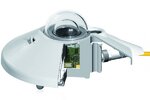mechguy
Newbie level 5
Hello,
I have a project to build a photodiode circuit with microcontroller to measure solar irradiance. The function of OpAmp is to limit the analog voltage to A/D converter, as shown in attached picture below. Vout will be connected to A/D converter (Vout = Ip * R1).
My problem is, how to measure irradiance? (power per diode area). For my understanding in measuring power, I will use a voltmeter to measure voltage across photodiode, and multiply it with the photocurrent (Vp * Ip). Is that correct?
Kindly appreciate any help and suggestion. Thanks in advance! ;-)
I have a project to build a photodiode circuit with microcontroller to measure solar irradiance. The function of OpAmp is to limit the analog voltage to A/D converter, as shown in attached picture below. Vout will be connected to A/D converter (Vout = Ip * R1).
My problem is, how to measure irradiance? (power per diode area). For my understanding in measuring power, I will use a voltmeter to measure voltage across photodiode, and multiply it with the photocurrent (Vp * Ip). Is that correct?
Kindly appreciate any help and suggestion. Thanks in advance! ;-)




